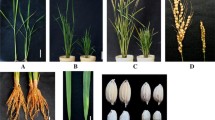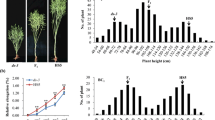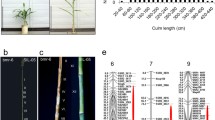Abstract
A dark green dwarf mutant, TGM 167, was isolated from a gamma ray + sodium azide mutagenised population of cultivated groundnut breeding line, TFDRG 5. The mutant had a 45.8% reduction in height due to its shorter internodal length. Further, it was found to be insensitive towards exogenous GA3 application, although it had nearly the same level of endogenous GA3 as the parent. Genetic analysis revealed that the dwarfism is under the control of a single dominant gene. This dominant dwarfing gene was mapped with an SSR marker TC3H02 at a distance of 9.7 cM.
Similar content being viewed by others
Avoid common mistakes on your manuscript.
Reduced plant height is an important agronomic trait associated with yielding capacity and lodging resistance in crop plants. A large number of dwarf mutants were isolated in different crop species and several of them have been characterised as gibberellic acid (GA) deficient or insensitive mutants. Either the disruption or abnormal synthesis of GA or the disruption of GA signal transduction can lead to dwarfism (Ueguchi-Tanaka et al. 2000). A common feature of GA-sensitive mutants is that they are recessive and deficient for GA because of a block in their biosynthetic pathway (Phinney 1984). Groundnut (Arachis hypogaea L.) is an important oilseed crop grown extensively in sub-tropical regions. Groundnut dwarf mutants were induced using X-rays (Patil 1966), gamma rays (Patil and Mouli 1978; Badigannavar and Mondal 2010), laser (Bozhan et al. 1997), diethyl sulfate (Ashri 1970), ethyl methane sulfonate (Gowda et al. 1996), ethidium bromide (Levy and Ashri 1975) and colchicine (Tiwari and Khanorkar 1984). Although enough information is available for the isolation of induced mutants in groundnut, their characterisation at biochemical and molecular levels is lacking. The present study reports on the isolation of a dominant dwarf mutant in groundnut and its preliminary biochemical and molecular characterisation.
Dry seeds (8–10% moisture) of TFDRG 5 (A. hypogaea ssp. fastigiata var. vulgaris) were treated with gamma rays (200 and 300 Gy) and/or sodium azide (NaN3 1, 2 and 3 mM) singly or as a combination of both (Badigannavar et al. 2005; Mondal et al. 2007). The M2 population having 20,619 plants was grown in the field during the rainy season (June to September) of 2004 and the dwarf mutant, TGM 167, was isolated along with other morphological and yield-related mutants and tested for their true breeding behaviour in the M3 and subsequent generations. TGM 167 belongs to botanical type A. hypogaea ssp. fastigiata var. vulgaris, like its parent. Further, all of the true breeding mutants, including TGM 167, were evaluated for their agronomic performances in the M8 (rainy season 2007) and M9 (summer 2008) generations and the agronomic data were analysed using IRRISTAT 2.0 software (International Rice Research Institute [IRRI] 2003).
The dwarf mutant TGM 167 was crossed with TFDRG 5. Segregation data for plant height in the F2 and F3 plants were subjected to the χ2 test for goodness of fit. A total of 1,114 published SSR primer pairs were screened between the parent and dwarf mutant. The SSR amplification, detection and data scoring were as described by Mondal and Badigannavar (2010). The polymorphic primer pairs were used for the genotyping of 73 F2 plants derived from TFDRG 5 × TGM 167 and TGM 167 × TFDRG 5 crosses. Kosambi map distances (Kosambi 1944) were estimated through linkage analysis between plant height segregation in the F2 population and SSR marker genotyping data using MAPMAKER version 3.0b (Lincoln et al. 1993) with a minimum LOD of 3.0.
Bioactive GA3 (Sigma, St. Louis, MO, USA) was dissolved in a small amount of absolute ethanol and diluted with distilled water. A field experiment was carried out by spraying 0, 10, 20, 40, 60, 80 and 100 ppm GA3 over the mutant in order to detect GA responsiveness. After 10 days of planting, the mutant and parent were sprayed daily until they were moist for a week in three replications, each consisting of ten plants. The height was measured from 40-day-old plants and compared with the untreated parent and mutant. In in vitro studies, surface-sterilised seeds (0.1% HgCl2) of the mutant and parent were placed in conical flasks having Murashige and Skoog media + 1% agar–agar (Murashige and Skoog 1962) with and without GA3 at 10−8, 10−7, 10−6, 10−5, 10−4 and 10−3 M in three replications. Each replication consisted of five flasks having four plants. The plants were grown at a 12/12-h day/night cycle and an average temperature of 28°C. The plant height was measured after 30 days. GA3 responsiveness for lipase production was studied in groundnut by mimicking the studies of α amylase activity in embryo-less seed cotyledons in cereals. Hence, the lipase activity was chosen over α amylase as the groundnut is an oilseed crop and the main storage products are triglycerides (oils) rather than starch. Four to five embryo-less quarter cotyledons per plate were surface-sterilised, washed and positioned perpendicularly on a tributyrin agar plate (5% tributyrin and 1.5% agar at pH 7.0) with or without GA3 (10−3 to 10−5 M). The GA plates were prepared by adding filter-sterilised GA3 solution to cold medium. The plates were checked for the clear zone of lipid hydrolysis after seven days of incubation at 28 ± 2°C in the dark. The quantification of endogenous GA3 was performed by gas chromatography fitted with a flame ionisation detector (GC 2014, Shimadzu, Kyoto, Japan). The apical meristem portion with two pairs of leaves was taken from 60-day-old plants of parent and mutant for GA3 extraction. The apical portion of the stem was ground to a fine powder in a mortar and pestle with liquid N2 and GA3 was extracted as per the method described by Reddy et al. (1989) for groundnut. Later, the extracts were esterified by the saponification–transesterification method using 0.5 N NaOH in methanol and 10% BF3 in methanol and were injected into gas chromatography apparatus. The gas chromatography chamber is equipped with an automated sampler, injector and a BP 1 (25-m) capillary column (SGE Analytical Science Pvt. Ltd., Victoria, Australia) coated internally with a thin film (0.25 μm diameter) of 100% dimethyl polysiloxane. The initial column temperature was 100°C and was held for 1 min, followed by an increase to 265°C at the rate of 25°C/min. The injector and detector temperature were set to 320 and 300°C, respectively. Gas flow rates of 3.5 (column flow), 30 and 300 ml/min for N2, H2 and air, respectively, were maintained. The GA3 content in the mutant and parent was identified and quantified by comparing the retention time of standard GA3 (Sigma, St. Louis, MO, USA) under the same temperature conditions and gas flow rates.
In the present study, a dwarf mutant TGM 167 was isolated from the treatment of 200 Gy gamma rays + 1 mM NaN3 with a mutation frequency of 4.85 × 10−5. In the M3 generation, dwarf plant bred true with a significant reduction in height as compared to the parent. The dwarf phenotype was maintained in TGM 167 from seed emergence until maturity. The plant height in TGM 167 was reduced by 45.8% as compared to TFDRG 5 (Table 1). Although there was no reduction in the number of internodes on the main axis in the mutant and parent, the internodal length was considerably shortened in the mutant (Table 1). Similar pod yield and shelling percentage with slightly reduced seed size was observed in TGM 167 as compared to TFDRG 5. All of the F1 plants from both direct and reciprocal crosses between the parent and mutant were dwarf, indicating the absence of involvement of cytoplasmic factors. The F2 plants were segregated as 3 dwarf:1 normal height. The segregation in the F3 plants was 1 (all dwarf):2 segregating (3 dwarf: 1 normal height):1 (all normal height) (Table 2). Both phenotypic and genotypic segregation revealed that dwarf trait in the mutant was conditioned by a single dominant gene. Most of the earlier studies reported that genes for dwarf mutants in groundnut were recessive (Ashri 1968; Patil and Mouli 1975; Bhuiyan 1984), dominant with recessive lethal effect (Ashri 1970) and incomplete dominant (Branch and Hammons 1983; Badigannavar and Mondal 2010). This is the first known report of a dominant dwarf mutant in groundnut.
The molecular mapping of agronomically important traits in groundnut is very limited. Lower molecular polymorphism is a common feature in cultivated groundnut due to a recent event of monophyletic origin followed by genome duplication (Moretzsohn et al. 2005). In our study, the screening of 1,114 published SSR markers between the parent and mutant revealed that only seven (0.63%) (TC3H02, TC3E02, TC11H06, IPAHM 659, IPAHM 468, EM 31 and pPGPseq_2H08) were polymorphic. The very low SSR polymorphism (0.63%) between the parent and mutant was expected, as induced mutants have nearly identical genetic architecture to the parents. The genotyping of F2 plants with all of these polymorphic SSR primers detected an expected 1:2:1 segregation for two markers (TC3H02 and IPAHM659) and the others had distorted ratios. Linkage analysis mapped TC3H02 at 9.7 cM from the dwarf locus in the mutant. The marker TC3H02 had also been mapped earlier to group I of the AA genome map (Moretzsohn et al. 2005) and linkage group Lg 5 in the SSR-based tetraploid linkage map (Hong et al. 2010) of groundnut.
Most of the plant species have the bioactive gibberellins in the form of GA3 and GA4. Previous reports in groundnut explained that 10 ppm GA3 was sufficient to induce height increment in a dwarf mutant with variable penetrance and expressivity (Ashri 1970). The spraying of GA3 (10, 20, 40, 60, 80 and 100 ppm) on the apical meristem of seedlings of TGM 167 (5.0–5.2 cm) showed no response in plant height increment as compared to untreated mutant (5.0 cm) and treated or untreated parent (12.5 cm; LSD = 0.32 at p = 0.05). Moreover, the mutant plants did not respond to the medium containing GA3 at different concentrations (10−8, 10−7, 10−6, 10−5, 10−4 and 10−3 M) under in vitro study. Further, there was no differential response even at 10−3 M (346 ppm) GA3 on lipase production in both the parent and mutant compared to the plate without GA3. Of the multiple peaks obtained using standard GA3 in gas chromatography, the major peak was observed at 9.5 min. The quantitative analysis revealed that the GA3 content in the mutant (132 ± 7 ng/g) was on a par with its parent (130 ± 11 ng/g of fresh weight). A similar phenomenon of accumulation of the same amount of native gibberellins in both the parent and mutant (D8) in maize explained a mutation in GA receptor that controls a product downstream from the binding of the bioactive GA to a receptor (Fujioka et al. 1988). Several such dominant dwarf mutants were reported in wheat and maize wherein mutation was detected in the orthologue of the Arabidopsis gibberellic acid-insensitive (GAI) gene.
References
Ashri A (1968) Morphology and inheritance of sterile brachytic dwarfs in peanuts, Arachis hypogaea. Crop Sci 8:413–415
Ashri A (1970) A dominant mutation with variable penetrance and expressivity induced by diethyl sulfate in peanuts, Arachis hypogaea L. Mutation Res 9:473–480
Badigannavar AM, Mondal S (2010) Induction of mutations for plant height and inheritance of dwarf mutant in groundnut (Arachis hypogaea L.) through gamma ray irradiation. Electronic J Plant Breed 1:156–161
Badigannavar AM, Kale DM, Mondal S, Murty GSS (2005) Trombay groundnut recombinants resistant to foliar diseases. Mutation Breeding Newslett Rev 1:11–12
Bhuiyan SA (1984) Inheritance of plant type in groundnut. Indian J Genet Plant Breed 44:215–217
Bozhan H, Yang LC, Jiezhen F (1997) Biological effects of laser and 60Co gamma rays on M1 plants of groundnut (Arachis hypogaea L.). Oil Crops China 19:12–14
Branch WD, Hammons RO (1983) Inheritance of a micro phenotype in peanut. Crop Sci 23:1045–1046
Fujioka S, Yamane H, Spray CR, Katsumi M, Phinney BO, Gaskin P, MacMillan J, Takahashi N (1988) The dominant non-gibberellin-responding dwarf mutant (D8) of maize accumulates native gibberellins. Proc Natl Acad Sci (USA) 85:9031–9035
Gowda MVC, Nadaf HL, Sheshagiri R (1996) The role of mutations in intraspecific differentiation of groundnut (Arachis hypogaea L.). Euphytica 90:105–113
Hong Y, Chen X, Liang X, Liu H, Zhou G, Li S, Wen S, Holbrook CC, Guo B (2010) A SSR-based composite genetic linkage map for the cultivated peanut (Arachis hypogaea L.) genome. BMC Plant Biol 10:17
International Rice Research Institute (IRRI) (2003) IRRISTAT for Windows. Version 4.4. International Rice Research Institute, Metro Manila
Kosambi DD (1944) The estimation of map distances from recombination values. Ann Eugen 12:172–175
Levy A, Ashri A (1975) Ethidium bromide—an efficient mutagen in higher plants. Mutation Res 28:397–404
Lincoln SE, Daly MJ, Lander ES (1993) Constructing genetic linkage maps with MAPMAKER EXP Version 3.0: a tutorial and reference manual. A Whitehead Institute of Biomedical Research Technical Report. Available online at: http://www.umanitoba.ca/afs/plant_science/psgendb/doc/mapmaker/mapmaker.tutorial.pdf
Mondal S, Badigannavar AM (2010) Molecular diversity and association of SSR markers to rust and late leaf spot resistance in cultivated groundnut (Arachis hypogaea L.). Plant Breed 129:68–71
Mondal S, Badigannavar AM, Kale DM, Murty GSS (2007) An induced dominant seed coat colour mutation in groundnut. Indian J Genet Plant Breed 67:177–179
Moretzsohn MC, Leoi L, Proite K, Guimarães PM, Leal-Bertioli SCM, Gimenes MA, Martins WS, Valls JFM, Grattapaglia D, Bertioli DJ (2005) A microsatellite-based, gene-rich linkage map for the AA genome of Arachis (Fabaceae). Theor Appl Genet 111:1060–1071
Murashige T, Skoog F (1962) A revised medium for rapid growth and bioassays with tobacco tissue cultures. Physiol Plant 15:473–497
Patil SH (1966) Mutations induced in groundnut by X-rays. Indian J Genet Plant Breed 26A:334–348
Patil SH, Mouli C (1975) Genetics of a dwarf mutant in groundnut. Theor Appl Genet 46:395–400
Patil SH, Mouli C (1978) Radiation induced bunchy top mutant in groundnut. Current Sci 47:22–23
Phinney BO (1984) Gibberellin A1, dwarfism and the control of shoot elongation in higher plants. In: Crozier A, Hillman JR (eds) The biosynthesis and metabolism of plant hormones. Cambridge University Press, Cambridge, pp 17–41
Reddy MN, Pokojska A, Kampert M, Strezelczyk E (1989) Auxin-, gibberellin-like substances and cytokinins in the seed and root exudates of groundnut. Plant Soil 113:283–286
Tiwari SP, Khanorkar SM (1984) Colchicine induced true breeding miniature mutant in groundnut. Current Sci 53:1262–1263
Ueguchi-Tanaka M, Fujisawa Y, Kobayashi M, Ashikari M, Iwasaki Y, Kitano H, Matsuoka M (2000) Rice dwarf mutant d1, which is defective in the α subunit of the heterotrimeric G protein, affects gibberellin signal transduction. Proc Natl Acad Sci (USA) 97:11638–11643
Acknowledgement
Our special thanks go to Shri R. K. Sachan for the help in the field experiments.
Author information
Authors and Affiliations
Corresponding author
Rights and permissions
About this article
Cite this article
Mondal, S., Badigannavar, A.M. & D’Souza, S.F. Inheritance and molecular mapping of a gibberellin-insensitive dwarf mutant in groundnut (Arachis hypogaea L.). J Appl Genetics 52, 35–38 (2011). https://doi.org/10.1007/s13353-010-0002-4
Received:
Revised:
Accepted:
Published:
Issue Date:
DOI: https://doi.org/10.1007/s13353-010-0002-4




